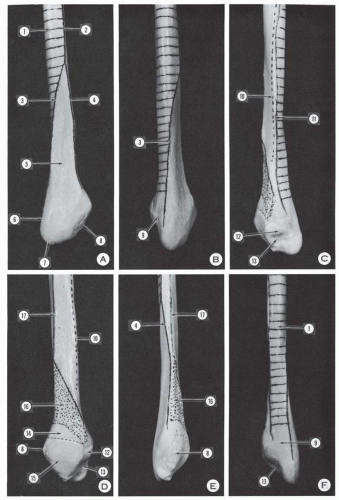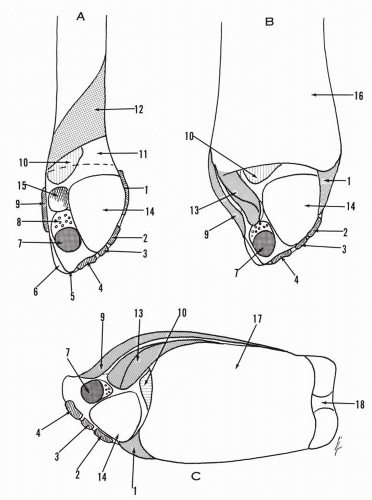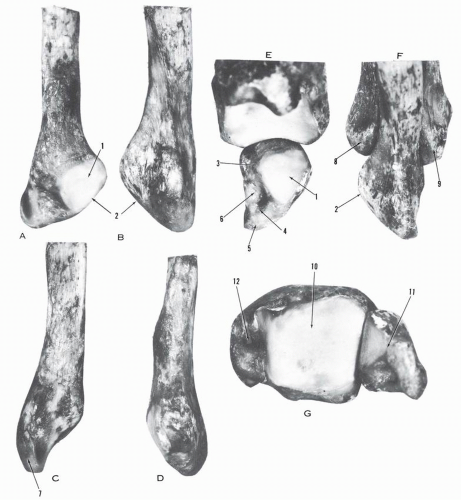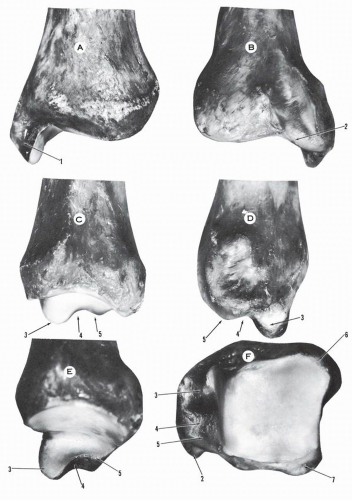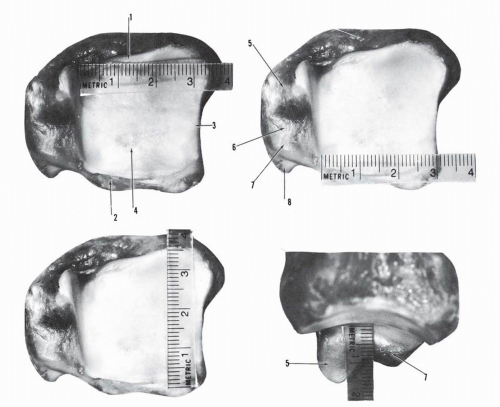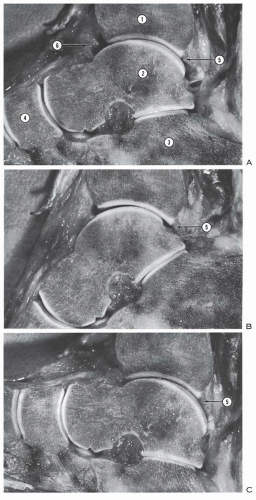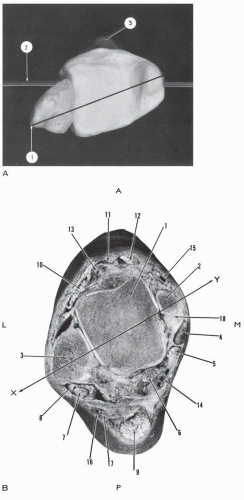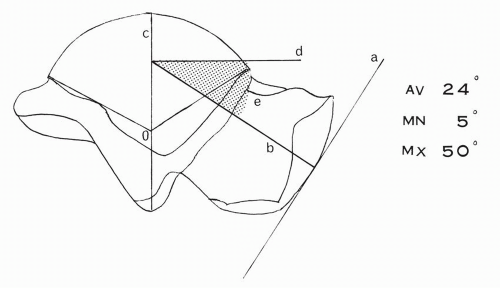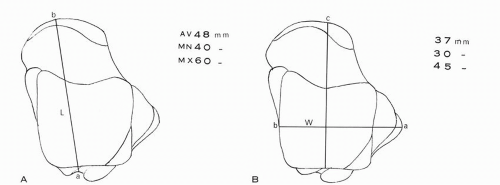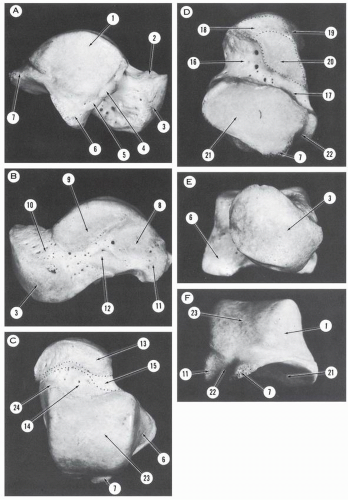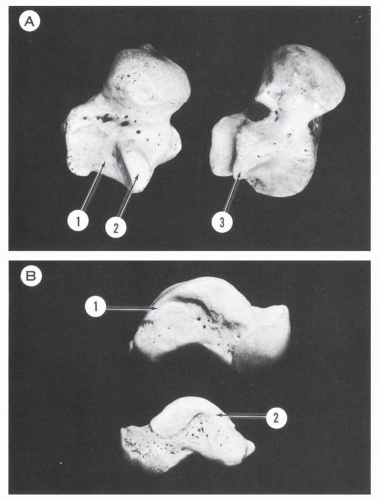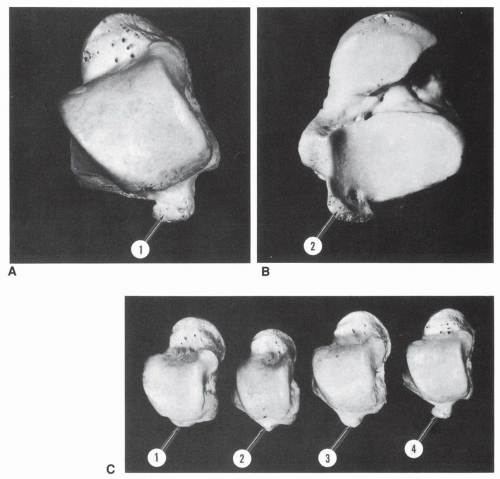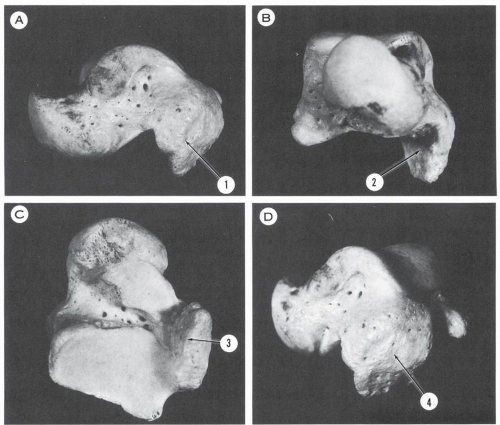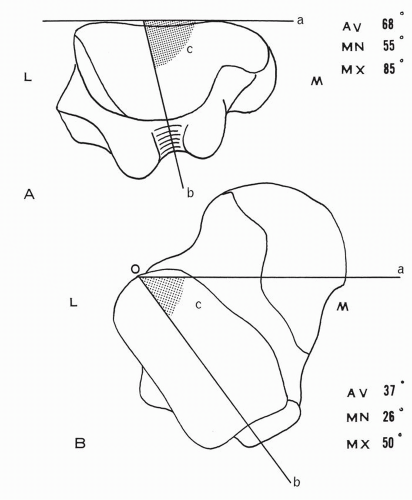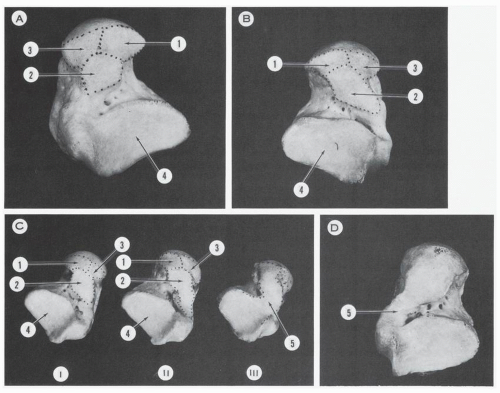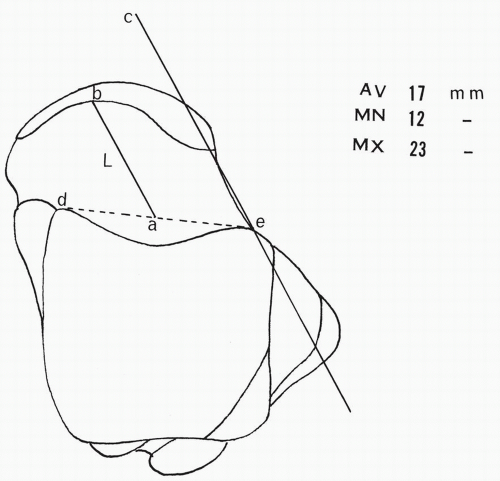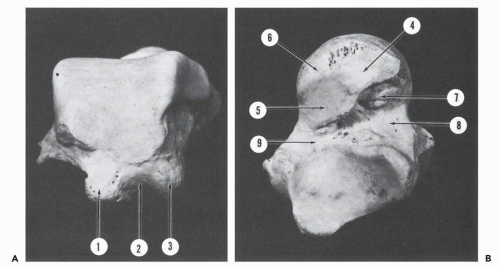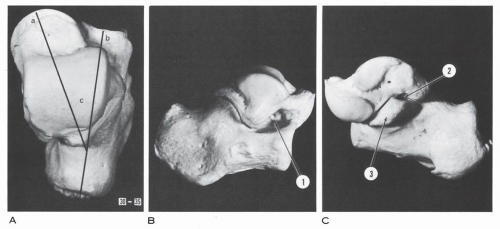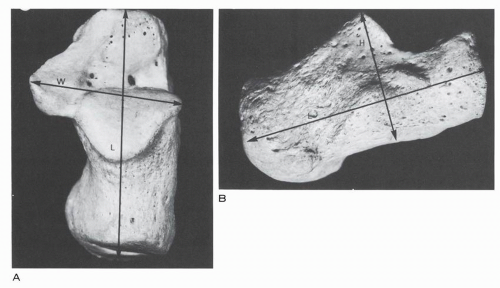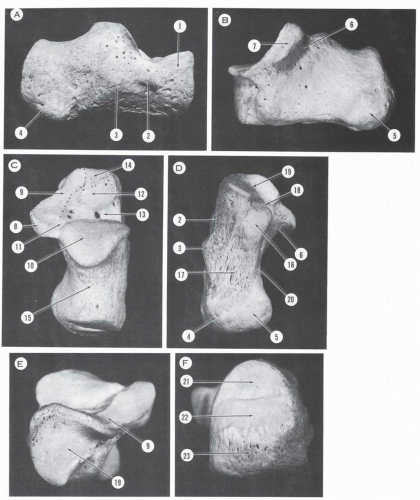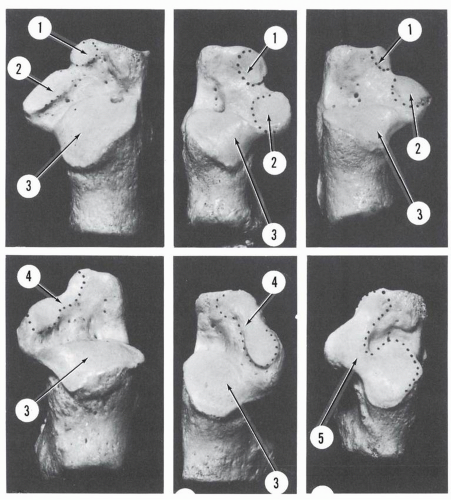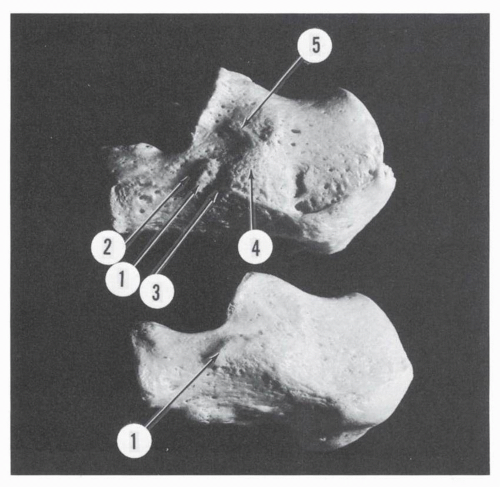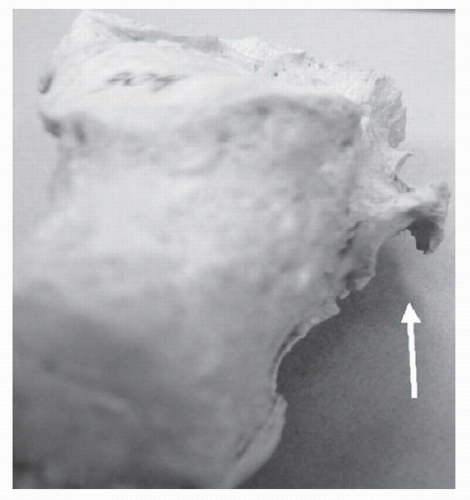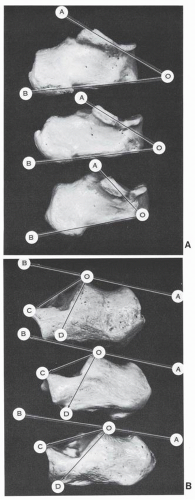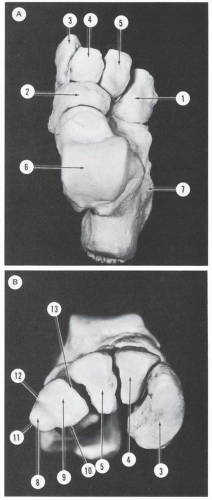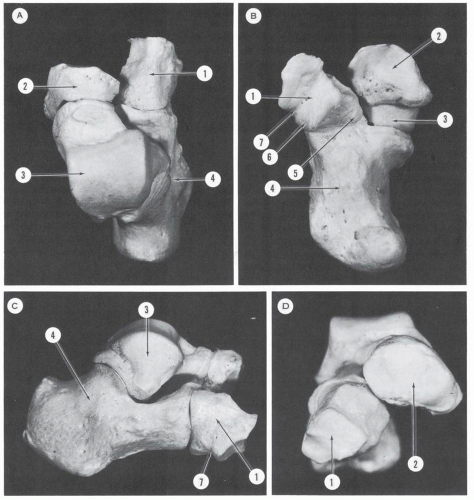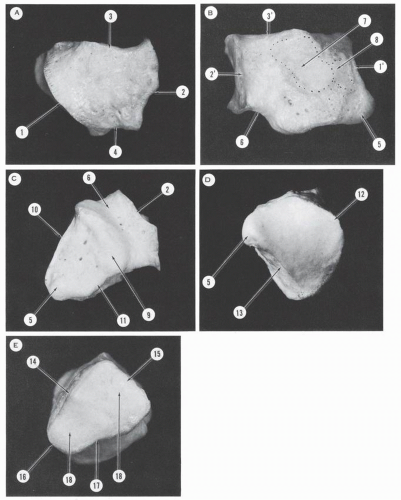surface occupies the anterosuperior aspect. The base of the triangle is proximal and convex. The apex is anteroinferior, located on the anterior border of the malleolus. The anterior border is inclined backward, whereas the posterior border is directed anteroinferiorly. The surface is convex along its long axis and corresponds to the lateral articular surface of the talus. Behind the posterosuperior angle of the triangular articular surface is the round posterior fibular tubercle, which gives origin to the deep component of the posterior tibiofibular ligament. Below the tubercle and behind the triangular articular surface is the digital fossa. The upper segment of the fossa is cribriform, with multiple vascular foramina. The lower segment gives origin to the posterior talofibular ligament. The superficial components of the posterior tibiofibular ligament originate from the posterior border of the peroneal tubercle and digital fossa (see Fig. 2.2).
of the sulcus is given as the narrowest, 5 mm; the majority (62%), 6 to 7 mm; and the widest, 10 mm. The lateral border of the posterior surface may become prominent and form a lateral bony ridge. “It helps to form a flange against which the tendons of the peroneal muscles play, and it gives attachment to some of the fibers of the superior peroneal retinaculum.1 The occurrence of this lateral bony ridge, based on Edwards’ data, is as follows: well-developed lateral bony ridge, 22%; slightly developed lateral bony ridge, 48% absence of a developed lateral bony ridge, 30%.-1 The majority of the ridges are 2 mm high, but occasionally the ridges may reach an elevation of 4 mm. Cartilage covering may increase the ridge 1 to 2 mm, and often the ridge is formed by cartilage only1
is an intra-articular segment. This surface may bear a small articular surface (squatting facet), usually lateral in location and very occasionally medial and lateral. The distribution of these facets is as shown in Table 2.1.
TABLE 2.1 DISTRIBUTION OF SQUATTING FACETS | ||||||||||||||||||||
|---|---|---|---|---|---|---|---|---|---|---|---|---|---|---|---|---|---|---|---|---|
| ||||||||||||||||||||
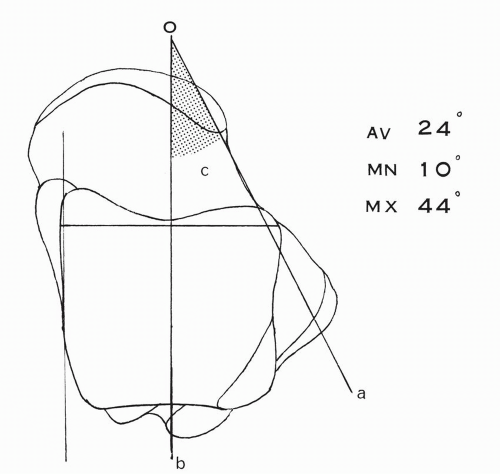 Figure 2.9 Declination angle (c) of the talar neck relative to the body, (a) Long axis of neck, (b) Long axis of body. |
TABLE 2.2 ANGLES OF DECLINATION AND INCLINATION IN TALUS | ||||||||||||||||||||||||
|---|---|---|---|---|---|---|---|---|---|---|---|---|---|---|---|---|---|---|---|---|---|---|---|---|
| ||||||||||||||||||||||||
apical portion. Rarely, a concavity replaces the convexity in this location. The vertical concavity is determined by the outward projection of the lateral talar process. The angle of projection as measured in 100 tali is 32 degrees average, 55 degrees maximum, and 15 degrees minimum (Fig. 2.14).
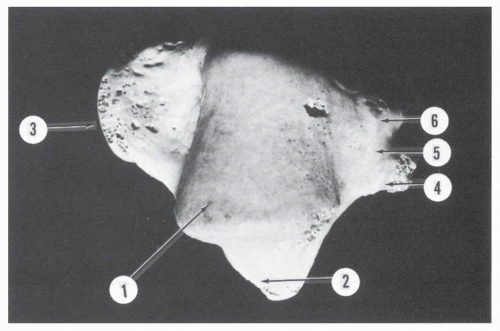 Figure 2.13 Superior aspect of talus. (1, talar pulley; 2, lateral process; 3, talar head; 4, posterolateral tubercle; 5, canal of flexor hallucis longus; 6, posteromedial tubercle.) |
TABLE 2.3 DIFFERENCE IN ANTERIOR AND POSTERIOR TRANSVERSE DIAMETERS | ||||||||||||||||||
|---|---|---|---|---|---|---|---|---|---|---|---|---|---|---|---|---|---|---|
| ||||||||||||||||||
TABLE 2.4 FREQUENCY OF OCCURRENCE OF MEDIAL EXTENSION FACET | ||||||||||||||||||
|---|---|---|---|---|---|---|---|---|---|---|---|---|---|---|---|---|---|---|
| ||||||||||||||||||
anteroposteriorly. The anterior third of this curve is part of a circle with a radius smaller than that of the lateral surface. The posterior two-thirds is an arc of a circle, the radius of which is larger than that of the lateral profile.6 Inman, contouring the trochlear surface in planes perpendicular to the functional axis of the ankle, found the medial side of the trochlea to be an arc of a circle in 80% of the tali and to deviate from it in the remaining 20%.3 The average arc on the medial side is 103 degrees ± 14.3
TABLE 2.5 FREQUENCY OF OCCURRENCE OF LATERAL EXTENSION AND SQUATTING FACETS | ||||||||||||||||||||||||||||||
|---|---|---|---|---|---|---|---|---|---|---|---|---|---|---|---|---|---|---|---|---|---|---|---|---|---|---|---|---|---|---|
| ||||||||||||||||||||||||||||||
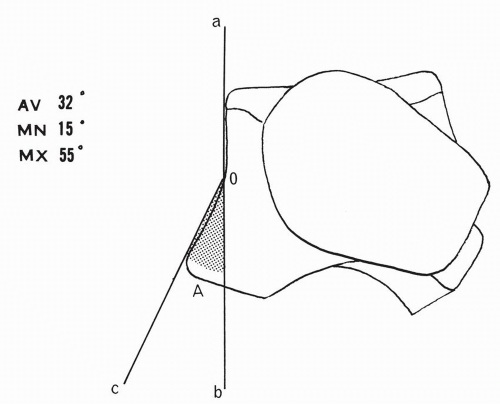 Figure 2.14 Angle of lateral projection (A) of talar lateral process. aob, tangential line to lateral surface; co, tangential line to lateral process. |
large and may extend downward over the os calcis, contributing to a talocalcaneal coalition (Fig. 2.20).
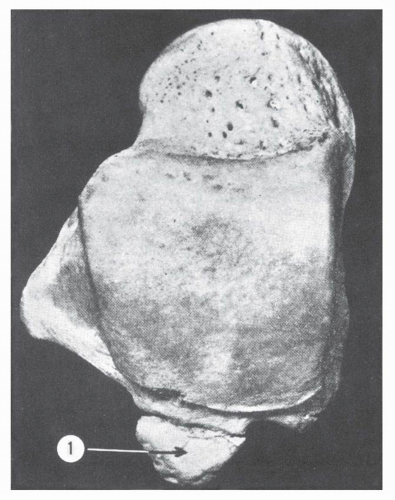 Figure 2.18 Os trigonum (1). (From Dwight T. Variations of the Bones of the Hands and Feet: A Clinical Atlas. Philadelphia: JB Lippincctt; 1907:14-23.) |
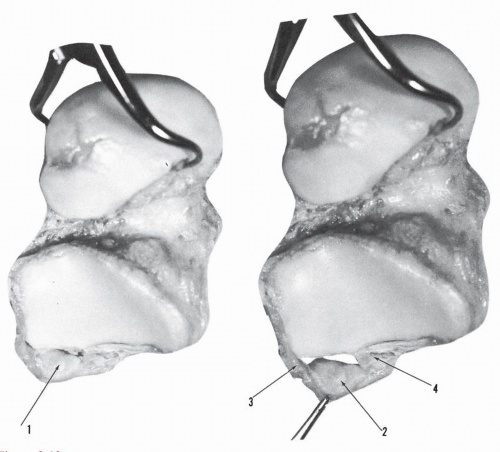 Figure 2.19 Os trigonum. (1, 2, inferior articular surface; 3, 4, ligaments of attachment on each side: thin anterior capsular structure has been removed.) |
TABLE 2.6 FREQUENCY OF OCCURRENCE OF OS TRIGONUM IN ADULTS | ||||||||||||||||||
|---|---|---|---|---|---|---|---|---|---|---|---|---|---|---|---|---|---|---|
| ||||||||||||||||||
corresponding to the inferior calcaneonavicular ligament (Figs. 2.22 and 2.24). A ridge may delineate these surfaces. Occasionally, a separation notch is seen between the surfaces; if the notch is deep enough, a near-complete separation occurs between the middle and anterior calcaneal surfaces. In rare instances, a complete separation is present.
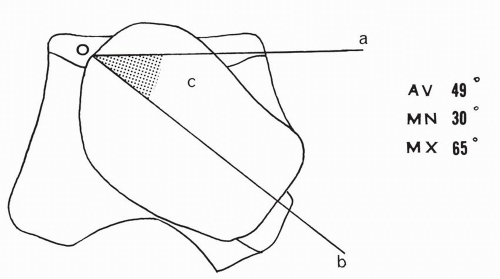 Figure 2.25 Angle (c) of lateral rotation of the talar head,(do, line parallel to trochlear surface; bo, long axis of head) |
 Figure 2.26 Variations in lateral rotation of talar head. (A) (I) Marked rotation. (II) Moderate rotation. (Ill) Minimal rotation. (B) Minimal rotation. |
the width was 53 mm maximum and 26 mm minimum.15 In the present series of 50 calcanei, the length was 75 mm average, 83 mm maximum, and 65 mm minimum; the width was 40 mm average, 46 mm maximum, and 35 mm minimum. The average breadth × 100/length index in the present series is 53 and may range between 50 and 60.15 The height of the os calcis is close to 50% of the length; in 50 calcanei, the average height was 40 mm, maximum 47 mm, and minimum 33.5 mm. The calcaneus is in the form of an irregular rectangle solid and presents six surfaces: superior, inferior, lateral, medial, posterior, and anterior.
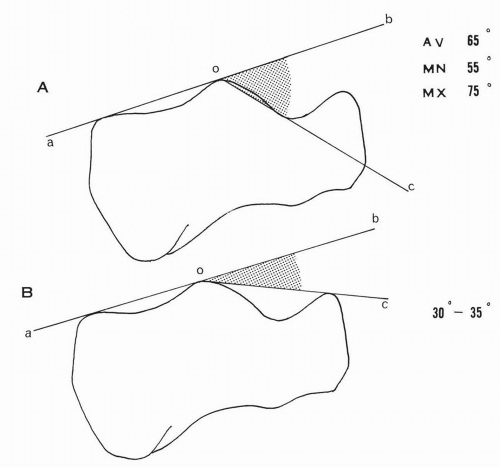 Figure 2.30 (A) Angle of inclination boc of the posterior talar articular surface. (B) Boehler tuberjoint angle boc. |
posterior facets are united into a single surface. The distribution of these variations is shown in Table 2.8 (Fig. 2.31).
TABLE 2.7 FREQUENCY OF OCCURRENCE OF ACCESSORY FACETS | ||||||||||||||||||||||||||||||
|---|---|---|---|---|---|---|---|---|---|---|---|---|---|---|---|---|---|---|---|---|---|---|---|---|---|---|---|---|---|---|
| ||||||||||||||||||||||||||||||
TABLE 2.8 FREQUENCY OF OCCURRENCE OF VARIATIONS IN CALCANEI | |||||||||||||||||||||||||||||||||||||||||||||||||
|---|---|---|---|---|---|---|---|---|---|---|---|---|---|---|---|---|---|---|---|---|---|---|---|---|---|---|---|---|---|---|---|---|---|---|---|---|---|---|---|---|---|---|---|---|---|---|---|---|---|
| |||||||||||||||||||||||||||||||||||||||||||||||||
articularis talaris anterior. The posteromedial corner of the sinus tarsi continues with the calcaneal or tarsal canal.
peroneal tubercle and occurred in 42.5% (Agra) and 2.42% (Lucknow).
Stay updated, free articles. Join our Telegram channel

Full access? Get Clinical Tree


